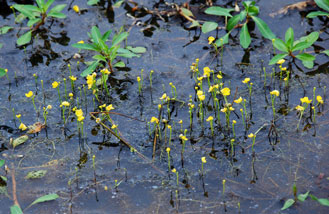CONE-SPUR BLADDERWORT
|
 |
| File Size: 141 KB |
|
|
|
Utricularia gibba L.
|
| McPherson County, Kansas |
| Perennial |
| Height: 1-6 inches |
| Family: Lentibulariaceae - Bladderwort Family |
| Flowering Period: July, August, September,October |
|
| Stems: | | Plants delicate, without roots, creeping in mud, at bottom of shallow water or on floating vegetation, or submersed, carnivorous. | | Leaves: | | Alternate, .12 to .6 inch, (thread-like) highly modified into finely dissected, branch-like segments bearing tiny ovoid or pear-shaped bladders that trap aquatic invertebrates, branches divided 1--3 times; bladders relatively few. | | Inflorescences: | | Racemes, terminal, 1-3(-8)-flowered; scapes .8 to 4 inches. | | Flowers: | | Pedicels .2 to .4 inch. Flowers: calyx 2-lipped, .06 to .12 inch, cleft to base, lobes entire; corolla yellow, sometimes drying pinkish, .2 to .4 inch, throat often closed by a conspicuous, rounded, often bearded palate of lower lip; lower lip entire or 3-lobed, upper lip entire or 2-lobed. | | Fruits: | | Capsules ovoid to globose, about .1 inch, subtended by persistent calyx; seeds brown or black, angular or ellipsoid. | | Habitat: | | Shallow water or mud along shores of marshes and small ponds. | | Distribution: | | Southeast quarter of Kansas | | Origin: | | Native | | Comments: | | The bladder-like traps of Utricularia are highly modified leaf divisions. The entrance to each trap is closed by two inward-opening flaps. When a trap is mechanically triggered by a small invertebrate, water suddenly rushes into the trap, carrying the animal with it. This movement is too rapid to be seen with the unaided eye. Digestion of the prey usually occurs in 48 hours or less. It is believed that digestion occurs via enzymes secreted by the plant, through bacterial action, or by a combination of the two. |
|
| Cone-spur bladderwort |  | | 129 KB | | McPherson County, Kansas |
| | Cone-spur bladderwort |  | | 143 KB | | McPherson County, Kansas |
| | Cone-spur bladderwort |  | | 111 KB | | McPherson County, Kansas |
| | Cone-spur bladderwort |  | | 99 KB | | McPherson County, Kansas |
| |
|
|
|
|
|
|